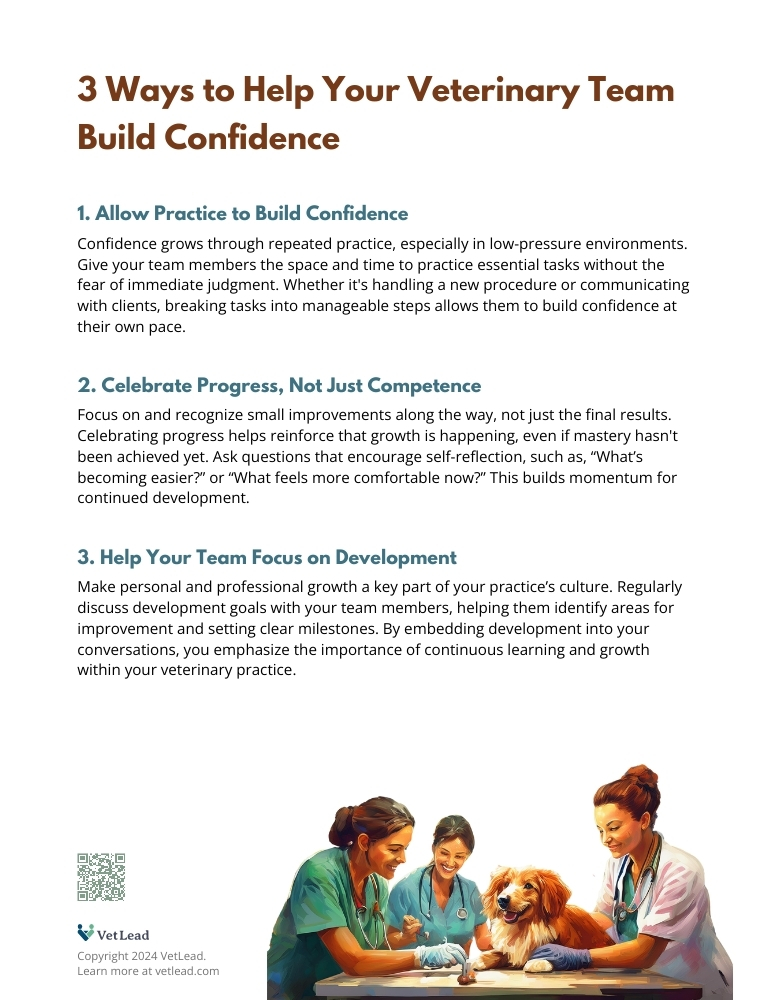As I work with veterinary practice leaders, one challenge that consistently comes up is how to help team members who lack confidence in their abilities to perform well. Whether it’s a new veterinary assistant uncertain about client interactions or a technician nervous about learning a new procedure, we know that confidence is an important part of high-level performance. Confidence often comes from the successful repetition of tasks, but the real challenge is figuring out how to help someone develop confidence when they’re not yet good at those tasks.
It’s a bit of a “chicken and egg” situation: a team member isn’t confident because they’re not performing well, but to perform well, they need at least some confidence in their abilities. This is a common issue in veterinary practices, where precision and communication are crucial to success. How can we, as veterinary leaders, help break this cycle? If we could master the art of building confidence in our team members, our leadership would be far more effective, and our practice would thrive.
Recognizing Task-Specific Confidence in Veterinary Professionals
Confidence often seems like a broad personality trait, but it’s more task-specific than we might realize. In a veterinary practice, a team member who lacks confidence in dealing with challenging clients might feel perfectly at ease performing technical tasks like taking X-rays or prepping a patient for surgery. As leaders, we often make the mistake of attributing a lack of confidence to the person rather than the task. This thinking can prevent us from helping our team members grow.
The Veterinary Leadership Program
Get info on this exclusive program.
Learn how to:
- 1Build an accountable team
- 2Make change happen
- 3Improve performance
- 4Hire exceptional talent
Includes live coaching.
Investment will be $897 per person
It’s essential to recognize that nearly everyone has confidence in something. A veterinary receptionist might feel uncertain about discussing pricing but be completely confident in handling the busy flow of the front desk. As leaders, it’s important to focus on the areas where team members show confidence and use that as a foundation to help them grow in other areas. If we assume someone will never gain confidence because of who they are, we risk limiting their potential.
Understanding the Brain’s Role in Confidence
To help team members build confidence, it’s useful to understand what’s happening in their brains. Confidence is linked to the brain’s value centers—the prefrontal cortex and the striatum. These areas work well when a person is calm, but they don’t function as effectively in high-stress situations. When someone appears confident, they usually seem calm because the task doesn’t cause them anxiety.
3 Ways to Help Your Veterinary Team Build Confidence
In veterinary practices, tasks like dealing with difficult clients, managing critical cases, or even presenting new ideas during team meetings can trigger stress, making it harder for team members to feel confident. However, it’s important to remember that confident people didn’t start that way—they built their confidence through practice and positive reinforcement. As veterinary leaders, we can create environments that allow our team members to develop confidence through practice and support, even in high-pressure situations.
1. Allow Practice to Build Confidence in Veterinary Skills
One of the best ways to help team members build confidence is to give them opportunities to practice without the pressure of immediate performance. Practice allows veterinary professionals to focus on learning without the stress of being evaluated or judged. When someone is practicing a task—whether it’s a technician learning how to assist in surgeries or a receptionist practicing how to handle billing questions—they’re not being scored or scrutinized. Instead, they’re focused on repetitions and improvement.
In a busy veterinary practice, it can be tempting to expect team members to excel immediately, but confidence takes time. For example, you might ask a team member to practice discussing a treatment plan with a client by role-playing with another staff member or yourself. You can break down the task into steps, allowing them to practice each one until they feel more comfortable. Similarly, when teaching a technician a new procedure, let them observe, then gradually take on more responsibility, one step at a time. The goal isn’t immediate competence but gradual improvement through practice.
2. Celebrate Progress, Not Just Competence

Veterinary professionals often feel pressure to perform at a high level immediately, but it’s crucial to celebrate progress, not just competence. Confidence builds when someone sees themselves improving, even if they haven’t mastered the skill yet. When you help your team focus on progress, you encourage them to keep going, which ultimately leads to greater confidence.
This doesn’t mean handing out trophies for small victories. It’s about recognizing meaningful improvements. Ask questions like, “What’s starting to feel more comfortable?” or “What’s becoming clearer as you go?” These kinds of questions help team members identify their own progress. When they can see and feel their improvement, they’re more likely to believe that they’ll eventually master the skill.
For example, if a veterinary nurse is learning to communicate more effectively with clients, you might notice and celebrate the way they asked a good follow-up question in a recent appointment. This recognition helps build confidence, making it easier for them to take on bigger communication challenges, like explaining complex treatment plans. Confidence compounds over time, and it’s our job as leaders to help our team members recognize and build on their progress.
3. Help Your Veterinary Team Focus on Development
As veterinary leaders, it’s essential to make development a key focus for our team. It’s easy to get caught up in the day-to-day tasks and forget the importance of growth, but continuous development is critical for a thriving practice. One way to keep this focus is by regularly discussing growth opportunities with your team. Ask questions like, “What skill do you want to improve this quarter?” or “What’s something you’d like to learn more about?”
By embedding development into your practice’s culture, you send a message that growth is just as important as the daily tasks. For instance, if you lead a weekly team meeting, consider setting aside time for skill-building discussions or sharing learning experiences. This not only fosters a growth mindset but also gives team members the opportunity to reflect on their development in real-time.
Leading Your Veterinary Team to Confidence
The impact we have as veterinary leaders is immense, and one of our greatest opportunities is to help our team members build confidence in areas that matter to them and to the practice. By allowing practice, celebrating progress, and emphasizing development, we create an environment where confidence can grow. This ultimately transforms not only individual team members but also the overall performance and atmosphere of our veterinary practices.
Watching someone move from uncertainty to confidence—whether in surgery, client communication, or leadership within the practice—is incredibly rewarding. It changes the future for that individual and the entire team. By cultivating confidence in our veterinary teams, we are fostering a more resilient, capable, and high-performing practice.

Download this PDF Now
3 Ways to Help Your Veterinary Team Build Confidence
Share it with leaders and teams. No email address required.
How do you inspire confidence on your team? Let us know in the comments below.
